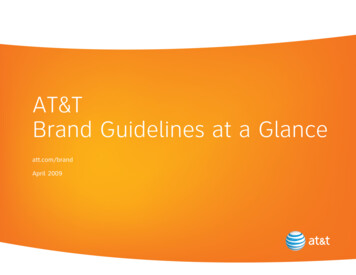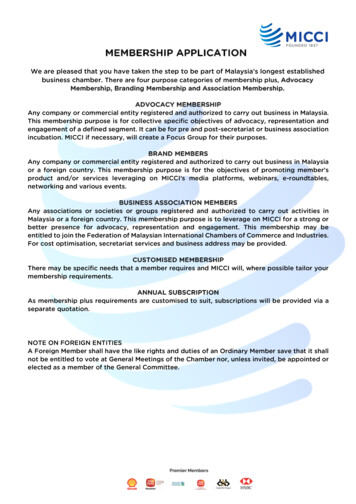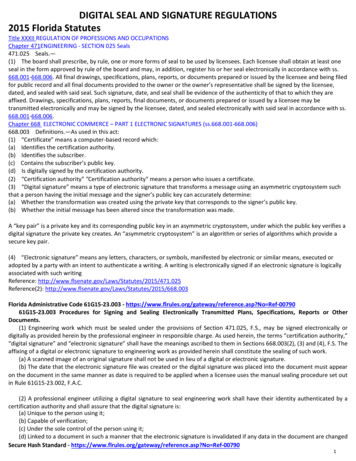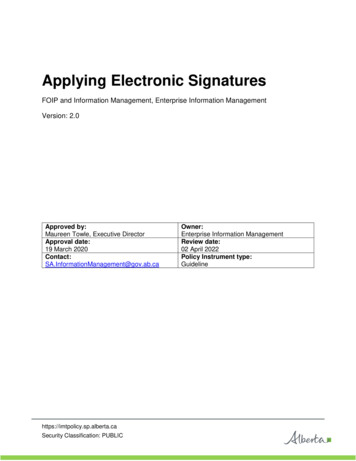
Transcription
Physical Therapy’s Role inBehavioral and Mental HealthPTs in Hospice and Palliative CareUncompensated CareOctober 2021Vol. 13 No. 9The Signature Membership Publication of the American Physical Therapy AssociationDevelopingLeadership &BusinessSkills
BETHETo Engage Patients& Propel Your PracticeCaring for your patients. Thriving asa business. That’s what matters. Andto make that happen, you need a singleintegrated technology platform—notdisparate solutions. Better workflows.Revenue capture. Claims and insuranceprocessing. Interoperability. Plus a superior way to engage with patients.All from one trusted source, who will bethere for the life of your practice.See what an integrated technology platformcan do for you: NextGen.com/1-pt 2021 NXGN Management, LLC. All Rights Reserved. NextGenis a registered trademark of NXGN Management, LLC. All othernames and marks are the property of their respective owners.
Improved Mobility.Made Easier. L300 Go is a functional electrical stimulation(FES) system which activates the nervesand muscles that lift the foot.Facilitates muscle re-educationPrevents/retards disuse atrophyMaintains or increases jointrange of motionIncreases local blood flowL300Go.com 844.669.2653Important Safety Information and Risks:For Indications for Use, Contraindications, Warnings,Adverse Reactions, Precautions, and othersafety information please refer towww.bioness.com/Safety and Risk Information.php(also available in the L300 Go Clinician’s Guide).Individual results may vary. Patients are advisedto consult with a qualified physician to determineif this product is right for them.L300 Go , Bioness, the Bioness Logo and LiveOn are trademarks of Bioness Inc.www.bioness.com Rx Only 2021 Bioness Inc.03617
IN THIS ISSUEOctober 2021Vol. 13 No. 9COLUMNS14Compliance MattersResults of a recent APTAsurvey provide insightsinto the challenges ofuncompensated care.60Defining MomentDefining momentscan come more thanonce in life.28DevelopingLeadership andBusiness SkillsWhy PTs and PTAs need these important traitsif they want to be A Asks49Professional PulseHealth Care HeadlinesAPTA Leading The WayStudent FocusAPTA Member Value5618Physical Therapy’sRole in Behavioraland Mental HealthBehavioral health and mental healthare part of a patient’s overall wellness status. How do PTs and PTAscontribute?38PTs in Hospice andPalliative CarePhysical therapy is important forpatients in an end-of-life scenario.Here’s why.Centennial Spotlight100 Days of ServiceAPTA Centennial LecturesThis Month in History58MarketplaceCareer OpportunitiesContinuing EducationProducts58Advertiser Index2APTA.ORG/APTA-MAGAZINE
It doesn’t take a lot of time.“Helen Owens, PT, DPTHomer Glen, ILAPTA member since 1986Custom orthotics are wonderful to help restorebiomechanics for the patient. It’s easy to doin the clinic. Doesn’t take a lot of time. It’svery beneficial for patients. I’ve been in practicefor 42 years, and I’ve been using Foot Levelers for 40of those years. Not only do I trust this product, butI’m also a consumer of this product.Why choose Foot Levelers? ”Flexible orthotics for motion and core stabilityHand-crafted since 1952Made in the USA100% money-back guaranteeSuperior customer supportIncorporate Custom Orthotics intoYour Care Plan Today 888.966.0970FOOT LEVELERSFootLevelers.com
QUOTED“Treating ACL tearsmay be ‘sexy,’ andmanaging highlevel patientsreceiving workers’compensation sothey can return towork is meaningful,but those in hospiceand palliative carehave needs andwants like everyother patient.”Rob Pace, PT, MSPT,in “PTs in Hospiceand Palliative Care,”on Page 38.3030 Potomac Ave., Suite 100Alexandria, VA 22305-3085703-684-2782 800-999-2782aptamag@apta.orgAPTA Board of DirectorsOFFICERSSharon L. Dunn, PT, PhD, PresidentMatthew R. Hyland, PT, PhD, MPA, Vice PresidentKip Schick, PT, DPT, MBA, SecretaryJeanine M. Gunn, PT, DPT, TreasurerWilliam (Bill) McGehee, PT, PhD, Speaker of the HouseKyle Covington, PT, DPT, PhD, Vice Speaker of the HouseDIRECTORSSusan A. Appling, PT, DPT, PhDCynthia Armstrong, PT, DPTCarmen Cooper-Oguz, PT, DPT, MBADeirdre “Dee” Daley, PT, DPT, MSHPESkye Donovan, PT, PhDHeather Jennings, PT, DPTDan Mills, PT, MPTRobert H. Rowe, PT, DPT, DMT, MHSVictoria S. T. Tilley, PTEditorial Advisory GroupCharles D. Ciccone, PT, PhD, FAPTAGordon Eiland, PT, ATC, MAChris Hughes, PT, PhDPeter Kovacek, PT, DPT, MSARobert Latz, PT, DPTJeffrey E. Leatherman, PTAllison M. Lieberman, PT, MSPTKathleen Lieu, PT, DPTAlan Chong W. Lee, PT, DPT, PhDLuke Markert, PTADaniel McGovern, PT, DPT, ATCNancy V. Paddison, PTA, BATannus Quatre, PT, MBAKeiba Lynn Shaw, PT, MPT, EdDNancy Shipe, PT, DPT, MSJerry A. Smith, PT, ATC/L, MBAMike Studer, PT, MHS, FAPTASumesh Thomas, PT, DPTMary Ann Wharton, PT, MSMagazine StaffDonald E. Tepper, donaldtepper@apta.org, EditorMonica Baroody, Contributing News EditorTroy Elliott, Contributing News EditorJan Reynolds, Contributing News EditorMichele Tillson, Contributing News EditorMichelle Vanderhoff, Contributing EditorAssociation StaffLois Douthitt, PublisherJason Bellamy, Senior Vice President,Member ExperienceAlicia Hosmer, Senior Director, Brand Strategyand CommunicationsJustin Moore, PT, DPT, Chief Executive OfficerJulie Hilgenberg, juliehilgenberg@apta.org,Advertising Manager 2021 by the American PhysicalTherapy Association. APTAMagazine (ISSN 2691-3143) ispublished monthly 11 times ayear, with a combined December/January issue, by APTA, 3030Potomac Ave., Suite 100,Alexandria, VA 22305-3085.SUBSCRIPTIONS: Annualsubscription, included in dues, is 10. Single copies 20 US/ 25outside the US. Individualnonmember subscription 119US/ 139 outside the US ( 199airmail); institutional subscription 149 US/ 169 outside the US( 229 airmail). No replacementsafter three months. Periodicalspostage paid at Alexandria, VA,and additional mailing offices.POSTMASTER: Please sendchanges of address to APTAMagazine, APTA Member Success,3030 Potomac Ave., Suite 100,Alexandria, VA 22305-3085;703-684-2782. Available online inHTML and a pdf format capableof being enlarged for the visuallyimpaired. To request reprintpermission or for general inquirescontact: aptamag@apta.org.DISCLAIMER: The ideas and opinions expressed in APTA Magazineare those of the authors, and do notnecessarily reflect any position ofthe editors, editorial advisors, or theAmerican Physical Therapy Association. APTA prohibits preferentialor adverse discrimination on thebasis of race, creed, color, gender,age, national or ethnic origin, sexualorientation, disability, or healthstatus in all areas including, butnot limited to, its qualifications formembership, rights of members,policies, programs, activities, andemployment practices. APTA iscommitted to promoting culturaldiversity throughout the profession.ADVERTISING: Advertisementsare accepted when they conformto the ethical standards of APTA.APTA Magazine does not verify theaccuracy of claims made in advertisements, and publication of an addoes not imply endorsement by themagazine or APTA. Acceptance ofads for professional developmentcourses addressing advanced-levelcompetencies in clinical specialtyareas does not imply review orendorsement by the AmericanBoard of Physical Therapy Specialties. APTA shall have the right toapprove or deny all advertising priorto publication.DesignTGD Communications, creative@tgdcom.comAdvertising SalesPRODUCTS/CONTINUING EDUCATION ADVERTISINGThe YGS Group3650 W. Market St., York, PA 17404717-505-9701 800-501-9571Zack Buchanan, zack.buchanan@theygsgroup.comRob Glass, robert.glass@theygsgroup.comRECRUITMENT/EMPLOYMENT ADVERTISINGYour Membership541 Eastern Point Road Suite 3, Groton, CT 06340727-497-6565Meredith McCauleymeredith.mccauley@communitybrands.com4APTA is committed to being agood steward of the environment.APTA Magazine is printed usingsoy-based inks as defined by theAmerican Soybean Association,is packaged using recyclable film,and uses a Forestry StewardshipCouncil-certified supplier thatrecycles unused inks into reusableblack ink, recycles all press platesinto aluminum blocks, recyclesall manufacturing waste, and purchases ink from suppliers whosemanufacturing processes reduceharmful VOCs (volatile organiccompounds).APTA.ORG/APTA-MAGAZINE
DON’TMISS OUT!Earn up to20 live hours*PT Vestibular Series10 LIVE WEBINARS 2-HOUR COURSES12:00-2:00 pm ET October 18-22 & November 1-5Guest Editor: Mike Studer, PT, MHS, NCS, CEEAA, CWT, CSST, FAPTATopics include: Acute dizziness vertigo Anatomy physiology BPPV Peripheral vestibularhypofunction Vestibular-relatedimpairments in childrenVestibular migrainesREGISTER NOW: PhysicalTherapy.com/VestibularSeriesSpace is limited!Become a PhysicalTherapy.com member for access to all 10 live webinars. Membership alsogives you unlimited 24/7 access to 450 evidence-based online courses in multiple convenientformats. New live webinars are added weekly! After the live series ends, courses will be availableas recorded webinars.PhysicalTherapy.com is a nationally recognized CEU provider and a BOC Approved Continuing Education Provider.*Check your state rules for live course requirements.866-833-1421
VIEWPOINTSAPTA welcomesyour opinions andencourages diversevoices.OpinionThe Power of Human Connection:An ICU Recovery Clinic PerspectiveIt was during a 12-week clinical rotation inthe intensive care unit that I first encounteredpatients with critical illness. Those early studentexperiences made me forget my initial desire towork in sports physical rgAPTA Engageengage.apta.orgWe will considerletters, email,and social mediaposts that relateto magazinearticles or are ofgeneral interestto the profession.Responses may beedited for clarity,style, and space, anddo not necessarilyreflect the positionsor opinions of APTAMagazine or theAmerican PhysicalTherapy Association.6My unexpected and circuitous path has yieldedmany serendipitous opportunities. Workingin the ICU Recovery Clinic at the University ofKentucky has permitted me to treat and developmeaningful relationships with patients recovering from critical illness, and it has taught mea lot about life with and after such an illness. Iam forever grateful to the survivors who haveallowed me to play a small role in their recovery.This perspective is dedicated to the survivors,the ones still in recovery, those we have lost, andtheir family members.The ICU Recovery Clinic was created in 2012 bya physician with local roots, Ashley Montgomery-Yates, MD, who identified a dire need fortreatment of ICU survivors in our region. Fastforward a few years, and the clinic had blossomed into a place with a transdisciplinary focus— including providers from pharmacy, nursing,respiratory therapy, pulmonology, and criticalcare, as well as the patient and family members,in the plan of care. Our team didn’t know it atthe time, but our experience in the clinic waspreparing us for an unimaginable storm.On March 26, 2020, we assessed and treated ourfirst patient surviving severe COVID-19 who hadrequired mechanical ventilation in the ICU.Since that day, we have continued to care formore than 100 individuals recovering from someof the worst cases of COVID-19 in Kentuckyand surrounding states. Treatments come in allforms, including in-person visits, telehealth, andphone follow-ups.As the physical therapist on the team, my roleis to assess physical impairments and developintegrated treatment plans to promote recoveryand quality of life. My assessments follow theCOVID-19 Core Outcome Measures developed byAPTA’s Cross-Academy/Section COVID-19 CoreOutcome Measure Task Force. They also includea few personal favorites: the dual-task Timed-Upand Go Test and Six-Minute Walk Test.To optimize care delivery for patients livingoutside our driving radius, I am a liaison withthe rehabilitation specialists in communitiesthroughout our region. In addition, I frequentlychampion the performance of self-reportedoutcome measures for emotional health andquality of life. I also communicate with the transdisciplinary team about our patients’ physicalfunction and ability to return to driving and work.While I’m grateful for the opportunity to helpthese patients and their providers on the roadto recovery, I’m even more grateful for whatthese patients have taught me along the way.The experience of surviving a critical illnesscan bring out some truly remarkable qualitiesin people — qualities I hope to embrace in myprofessional and personal life. I’ve witnessedlevels of vulnerability, resilience, and generosityin these patients that leave me in awe. Here aresome examples of what I’m talking about.Vulnerability is the state of being exposed tophysical or emotional harm. Critical illness ofany origin is traumatic, and patients frequentlyexperience anxiety, depression, and posttraumatic stress disorder. Psychological trauma isfurther exacerbated by the constant presence ofCOVID-19; patients cannot escape the constantreminders when they turn on the television orlook at their phone, and each mention triggersmemories of the ICU.One patient, an armed services veteran, told usthat his time in the ICU was more traumatic thanhis years of combat. Other survivors have toldus about the psychological effects of COVID-19.For example, a patient who required prolongedmechanical ventilation shared a frighteningAPTA.ORG/APTA-MAGAZINE
VIEWPOINTSstory about distorted perceptions ofreality. During her time in the ICU, shebelieved she was kidnapped, restrained,and kept in a freezer in an unfamiliarbasement.In a similar testimonial, another survivorshared that he believed the intermittentpneumatic compression devices on hislegs, meant to prevent deep vein thrombosis, were a pack of rabid dogs trying tognaw off his toes and shins.All three stories are disconcerting, buteven more disheartening is the persistentemotional distress that continues afterdischarge. Patients often report frequentnightmares, altered social roles, dependence on loved ones for care, and financialhardships, including lost wages due to aninability to work.To be vulnerable and to trust our teamenables a more profound connection. Thisconnection breaks the traditional barriersof the patient-provider relationship. I findmyself sharing tears at almost every clinic.Tears of sadness, tears of letting go of thepast, tears of accepting a new normal, andtears of triumph.Resilience refers to the ability to recoverquickly from difficulties. But recovery iscertainly multifactorial, and the adverb“quickly” is relative. Patients in our clinichave diverse trajectories of recovery. Wehave patients who are still struggling oneyear after their ICU admission. Regardlessof their current stage of recovery, ourpatients demonstrate the resiliency tocarry on, despite what may appear to beimmovable obstacles.For example, one patient reported a newoutlook on life despite his post-COVID-19physical and cognitive impairments. Priorto COVID-19, he was healthy and employedin a labor-intensive job. His diagnosis ledto weeks in the ICU, requiring extra-corporeal membrane oxygenation. Six monthsafter discharge from the ICU he still wasunable to walk without an assistive deviceand bilateral AFOs due to significantpolyneuropathy. What seemed to be theworst hand dealt was trumped by celebrating the small victories in recovery —like showering on his own and cherishingevery moment spent with children andgrandchildren.It is these triumphs that help us buildresilience. Our patients have inspired meto work harder, to be a better physicaltherapist, and to live life with purpose.They have taught me to cherish the upsand downs, and all the truly importantthings in life.In treating patients recovering from severeCOVID-19, I have never experiencedmore generosity from a group of humanbeings. They give back in so many ways,whether it’s a small token of appreciation,a thank-you card to the ICU nurses, or agrand presentation in front of hundredsof attendees during a town hall meeting.They are generous to share their storiesand frequently volunteer to help otherswho may be going through similar battles.Many also are participating in translationaland clinical research. Their participationin research has been wide and varied,including basic science, donating biospecimens, and enrolling in large multisitenational clinical trials.Without their vulnerability, resilience,and generosity, I am not sure where wewould be in this pandemic. Many patientsare still suffering, and the uncertainty ofCOVID-19 continues to be concerning, butI have hope.My role as a physical therapist in an ICUand COVID-19 recovery clinic is minuscule compared with the daily grind of ICUand COVID-19 survivorship. My role hasopened my eyes to the power of physicaltherapy and, more important, the power ofmeaningful human relationships.KIRBY P. MAYER, PT, DPT, PhD(This originally appeared as “The Powerof Human Connection: An ICU RecoveryClinic Perspective” on Aug. 4, 2021, as aperspective piece on apta.org.)OCTOBER 20217
VIEWPOINTSThe PTA Differential Just Doesn’t Add Up —Especially for PatientsThe physical therapist assistant paydifferential that CMS is preparingto apply in 2022 isn’t just a matterof money. The policy also threatenspatient access to care and how weprovide that care, and it flies in theface of what we know to be truethrough our education to become PTsand PTAs.For my practice in central Missouri,the proposed payment differentialpresents several challenges. Thefinancial implications are obvious: Ata time when practices are saddledwith more administrative burden,struggling to recover from damagedone by a pandemic, and facingfurther reductions in payment, CMS isdevaluing one of our key strengths.The fact is that the work of our PTAsis crucial to many practices’ abilityto weather the mounting challengeswe face. Paying less for servicesprovided by a PTA only widens thegap between the cost of doing business and what we are paid.You don’t have to look at practicepatterns long to see that PTAs area vital component of most outpatient physical therapy practices. Aslicensed health care providers, PTAscan implement the therapy plan ofcare as prescribed by the patient’sprimary therapist while providing acost-effective staffing solution topractice owners.You don’t have to look at practicepatterns long to see that PTAsare a vital component of mostoutpatient physical therapypractices.8And thanks to relatively affordableand accessible PTA educationprograms across the country, theemployment pool for PTAs is largerthan that of PTs in many areas,including where I live. That means wehave a greater number of potentialcaregivers, skilled in and passionateabout helping patients move better.That’s good news for patientaccess — providing that access isn’tdecreased through harmful changesto payment.The training and education weundergo to become PTs and PTAsteaches us that our care cannot bebased on who’s paying for the service.Our care must be based on patientneed. And yet, payers — in this caseMedicare, but rest assured commercial payers will follow suit — seemto be able to place values on caredepending on their misperceptions ofthose providing the care. How doesthis make sense?The business reality is this: Anypayment differential for outpatientservices naturally “encourages”management to assign patient careto the provider who will generate thehigher revenue. The problem is thatthis approach comes at the expenseof both the lower revenue-generatingemployee and the patient.Very soon, a domino effect is created.If a PTA can’t generate the samerevenue as their supervising PT, theiremployer may have less work available for them or may eliminate theirpositions altogether. Patients in turnhave fewer available appointments,and access to care is reduced. Thisproblem is not easily overcome inrural areas like mine, where there arelimited PTs looking for employmentbut a surplus of PTAs.And the problems don’t end withpayment. CMS’ discrepancies for PTAsupervision by a PT creates an unfairobstacle for independent practiceowners. In private practice, thesupervising PT must be on-site duringthe delivery of care by a PTA, but inevery other setting the supervisioncan be “general,” or indirect. There isno difference in the care provided orthe patients treated between thesesettings. There is only a differencein how the claims are billed, whichis unrelated to the amount or type ofsupervision a PTA requires. This isjust another requirement that limits apractice’s ability to adequately staff aclinic and provide access to neededservices.These obstacles to delivery ofservices can only be overcomethrough advocacy aimed at CMS andCongress — and CMS and membersof Congress will only know theproblem exists when we communicate with them.APTA is providing opportunities tomake our voice heard to policymakerson this issue. It takes many voices tocreate the roar necessary to evokechange. It’s time for us to create thatroar — just imagine the thunder ofthe collective voice of each APTAmember! When it comes to advocacy,we are #BetterTogether.JENNIFER SCHNEIDERS, PT, DPT(This originally appeared as “The PTADifferential Just Doesn’t Add Up —Especially for Patients” on Aug. 4, 2021,as a perspective piece on apta.org.)APTA.ORG/APTA-MAGAZINE
UNLOCK YOUR PATIENTSBIOMECHANICS SECRETS!Powered by our EXCLUSIVE AI ALGORITHM, Digitsole Pro is your in clinic digital partnerto objectively measure biomechanical data not observed by the naked eye. Run and walk analysis Remotely monitor mobility with ourDigitsole smart insole Discover rich biomechanical data to guideclinical discussions for Plantar Fasciitis,Hallux Valgus, Achilles injuries, and more.RUNAll terrainincludingtreadmillsWALKFor usein anyenvironmentCOMING SOON - REHAB AnalysisSMART MOTION,EMPOWERING YOUSCAN HERE TOREGISTER FOROUR WEBINARSASK ABOUT OUR EARLY ADOPTER PROMOTION!TO LEARN MORE AND ACCESSA FREE DEMO GO TODigitsolePro.comContact us at: USASALES@DIGITSOLE.COM
VIEWPOINTSAdvancing Inclusion in the Classroom — and BeyondHow would you respond if someone suggested that you were a“biased” individual? Would you feel as though you were accusedof being discriminatory? Perhaps of stereotyping?After a class session last semester on thermal agent modalities,one of my first-year students, Nancy Ellis, SPT, (now in her secondyear of our physical therapy program) pointed out to me that allthe photos in my morning lecture displayed examples of certainphysical agents being used with subjects who had lighter skin.I felt incredibly convicted by this suggestion. It had not been amalicious instructional act, but in reviewing my slides the unintended shortcoming was evident. Their visual content, influencedby my own bias, did not reflect the diverse patient populations weare called to serve.Nancy made me aware of the deficiency not merely to bring it tomy attention but as an opportunity for necessary change.I went back to update the presentation in the hopes of addressingand correcting the situation for future classes. Like many faculty,rather than create original images for educational lectures, forspeed and efficiency I elect to perform a basic internet search toidentify suitable images that illustrate various techniques, assessments, or equipment. I gain permission if required and list theassociated citation for any adopted material so that proper creditcan be issued. I did the same for this slide presentation.10In searching for a suitable image of a paraffin bath, I was resoluteto persevere until my search yielded an example of a patient whobetter represents the diversity of our population. By entering only“paraffin bath” in a standard search engine, I was appalled torealize that I had to comb through over 300 images before findingone distinct image that aligned with my targeted search criteria.Why was this the case? And why should a physical therapyeducator struggle this much to ensure that their materials werereflective of all patients we routinely serve in the clinic? Although Ihad to infuse greater intention and focused determination into mysearch, my motivation led me to accomplish my aim.In careful reflection of this situation, I acknowledge that faculty,starting with me, can be more intentional in making small butnecessary changes in academic physical therapy to overcome atleast some of the bias they possess. If advanced, this process willempower students — who represent the future of our profession— from early stages of their training to recognize and embrace agreater calling to deliver equitable, inclusive care to every patientthey will eventually encounter.Having our actual population consistently reflected in our structured educational material reminds students that they will seepatients and clients of diverse backgrounds, experiences, andidentities when they are licensed providers, and reiterates thenecessity of consistently equitable care.APTA.ORG/APTA-MAGAZINE
VIEWPOINTSLooking ahead, faculty should be charged to holdthemselves accountable for strategically includingclassroom images that reflect an assortment of visualillustrations to create decisive points of emphasisand ensure that as many patient populations aspossible are represented across the physical therapycurriculum. In fact, other visual materials need morecareful consideration in terms of diversity: In labs,are supplies such as bandages, kinesiology tape, andwraps provided in various skin tones?From my experience, it started with making a smallbut important commitment to assess my bias andcreate a well-defined plan to shape and address theshortcomings that were revealed through this investigative form of inventory.those who create materials that may be used forillustrative and demonstration purposes in teaching —not to mention in provision of services and outreach tohealth care consumers — produce them using a widervariety of populations so that when we seek appropriate materials they actually exist for us to find.Ultimately, all members of our profession will benefitby our renewed commitment, and the comprehensivecare delivered by our perceptive future colleagues willbe notably transformative and holistic.BRIAN J. WILKINSON, PT, DPT(This originally appeared as “Advancing Inclusion inthe Classroom — and Beyond” on Aug. 18, 2021, as aperspective piece on apta.org.)To facilitate these efforts, other stakeholders andvendors also need to be conscientious. I hope thatGIVE PATIENTS THESUPPORT THEY NEEDChoose from a full line of lumbar and cervical support rolls that havehelped hundreds of thousands achieve freedom from common backand neck pain. Watch for the new Signature Series rolls and supports.These lumbar supports are crafted from the finest materials, featuringa luxurious suede-type fabric, embroidered detail and removable,adjustable straps.COMINGSOONThe Original McKenzie Signature SeriesSlimLine Lumbar SupportSuperRoll Lumbar SupportD-Section Lumbar Roll Original Lumbar Roll Cervical Roll Early Compliance Lumbar Roll Learn more at: OPTP.COM or call 800.367.7393OCTOBER 202111
VIEWPOINTSAPTA Asks What is the biggest challenge — or opportunity — posed by theCOVID-19 pandemic in the short and long term? How should theprofession respond?The COVID-19 pandemic gave us the wings of technology evenin the most difficult times and proved that we are always biggerthan our problems. If we put our skills and hearts to use forthe welfare of others, nothing can stop us from healing minds,treating diseases, and saving lives.AMRUTA BHADE, PTA, BSPTThe biggest challenge I have faced during the pandemic hasbeen the lack of recognition and understanding of the skillsand scope of physical therapist practice. In conversation withthe U.S. Centers for Disease Control and Prevention after I hadcontracted COVID-19, it was clear that in all of the proceduralplanning, no one was looking at the differences in approachto care between nursing, physician, and physical therapistservices. Infection prevention was focused on minimal patientcontact to reduce the risk of exposure but did not consider thatthe PT would need to engage in hands-on care with patients. Weneed to refocus our outreach education efforts to include therole of physical therapy in critical care, wound care, emergencycare, and cardiopulmonary care.MEGAN MITCHELL, PT, DPTWhat are you doing to promote diversity, equity, and inclusion, and toenhance cultural competence, in your clinic and in the profession?As a part of the emergency management team, I have addressedthe policies and procedures for disaster and mass casualtyresponses to include a more defined role for physical therapy,and to include specialty needs for those with mobility impairments who cannot walk through a decontamination shower andmanage ADLs independently. I also reviewed the language of thepolicy to address LGBTQ needs for safe care.We focus on the individual. Our culture sets high expectations,understands the unique values everyone brings to the table, andthen focuses to break down barriers of all sizes to give eachindividual the ability to succeed.MATTHEW CALENDRILLO, PTMEGAN MITCHELL, PT, DPTAPTA encourages diverse voices. “APTA Asks ” poses questions that all members are invited to address, and we’ll publish selected answers. Toparticipate, log in to the APTA Engage volunteer platform at engage.apta.org, find the APTA National — APTA Magazine Member Input opportunity,and click the Apply Today! button for a list of questions. Answer as many as you want. Responses may be edited for clarity, style, and space, and do notnecessarily reflect the positions or opinions of APTA Magazine or the American Physical Therapy Association.12APTA.ORG/APTA-MAGAZINE
Provide light-weight, flexiblecompression therapy withthe Coolflex Standard Calf.Coolflex Standard Calf is a low profile, easy to dongarment that promotes
L300 Go is a functional electrical stimulation (FES) system which activates the nerves and muscles that lift the foot. Facilitates muscle re-education Prevents/retards disuse atrophy Maintains or increases joint range of motion Increases local blood flow 03617_APTAmag_ad_r03v01.indd 1 6/9/21 12:00 PM











